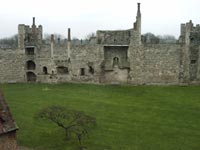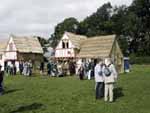The Medieval World
Medieval World Information
News
- coming soon
Links
Site Info
Welcome, Guest
The Feudal System
The medieval period is Europe was characterised by a form of social organisation known as "feudalism." This was a complex system of rights and obligations, under which land was held in return for service to the landowner. Under feudalism, medieval society formed a pyramid, with the King at the top. The King theoretically owned all the land in the country, parcelling it out to the lords, in exchange for (mainly military) support. As well as the land, the lord obtained rights to control its use and enforce the law within its boundaries. In turn, the lords delegated land to their subordinates, in exchange for the subordinates' promised service to the lord, and so on, until the level of the peasants, who actually worked the land. Typically, the peasant tenant's rent obligations involved working on the lord's demesne and/or giving part of their crop to the lord, with further obligation to fight for the lord when required. After the drastic fall in population due to the Black Death, money rents came to replace work on the lord's demesne.
The Norman conquest
The 1066 invasion was the most significant factor in shaping the development of British feudalism. However, even in those areas where Norman power was strongest - the agriculturally productive South and East - the distinctions between royalty and barons and knights were not very sharp until the end of the 16th century. In the North and West, older patterns of social relations tended to persist to some degree until the 16th century. In these areas, the basis of power was not rooted not so much in power over the distribution of land but in control of a kin goup.1
Lords
Feudal lordship was hereditary, with feudal rights and duties passing automatically to the eldest son on the lord's death. A lord was tied to his subordinates, and vice versa, through ties that might extend across several generations. A lord must be closely involved with his people. He lived in the territory which he held or risked losing it.
An essential feature of the feudal system was that political and economic relationships rested on personalised power. This contrasts with bureaucratic forms of social organisation, where the location and exercise of power are relatively impersonal, found in institutions rather than with specific individuals.
Power in the feudal hierarchy was never far removed from its basis in the use of violence. The Norman aristocracy had gained power through the force of arms and had held on to it in the face of cntinuing rebelion. The development of the Norman castle grew through the invaders' need to build fortifications throughout Britain to protect their position against native hostility and rival lords. Throughout the feudal era, the aristocracy had to show itself willing to fight to defend its position. When called to war by the king, a lord was expected to lead his men in person. Kings were expected to take a leading part in any wars they engaged in. The threat of violence was a crucial part of maintaining the power of the aristocracy. The wealthiest lords built castles in their territory, establishing a living base in the locality. A castle provided a defensible refuge and administrative centre which clearly expressed that the nature of the lord's power lay in military strength.
Peasants
The supporting pillars of medieval life were the agricultural workers. Their production of surplus food allowed the growth of the aristocratic ruling class thatwas far from frugal in its habits. Their surplus production alos allowed the growth of the medieval towns, centres of non-agricultural craft production, learning and religion.
Craftsmen - The growth of towns
The great cathedral building era was among the factors that encouraged the growth of crafts and focussed their development in the growing cities. Guilds were formed to protect the interests of the skilled tradesmen and ensure the quality of their work. Medieval crafts were developed to a high standard. Craft secrets were jealously guarded by the guilds, which regulated standards for each craft and which provided skilled workers with some control over prices and standards of their products. Relatively free from the constraints of local lords, when compared to the rural agricultural workers, guild members were often active in promoting social and political changes.
The Church
The church played a central role in medieval society. It was the main source of provision for orphans, widows, the sick, the disabled, the aged and the destitute; it provided schools and libraries and fostered learning; most opportunities for leisure time depended on the church calendar - Sundays and holy days; churches offered the poor access to art and music at a time of few other opportunities. It was the source of almost all scholarship. It provided education. It maintained libraries. The church provided careers for the non-militarily-inclined aristocrats. Altogether the Church played a larger role in people's lives at all levels of society than we can easily understand today. The higher reaches of the medieval church were extremely wealthy and powerful. The Medieval Church's power lay not just in its role of providing spiritual support for the feudal system. The Church was also engaged in economic activities on a large scale.
Additionally, the Church was itself of major economic importance. Abbeys were centres of agricultural production, producing food for the monks and nuns as well as for trade. The abbeys had tenants who were in a similar relationship to the abbey as the feudal tenant to the lord. Tithing allowed the church to take a share of both rural and urban production.
References:
1 . McNeill, T (1992) Castles London, BT Batsford/English heritage





